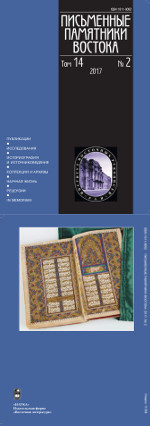 | PIS'MENNYE
PAMYATNIKI
VOSTOKA Vol. 14, No. 2 (29)
Summer 2017
Journal based in 2004
Issued quarterly
Selected Materials as a *.PDF file PUBLICATIONS
The “Second Logos of the Great Seth” (NHC VII.2). Introduction, Translation and Commentaries by Alexandr L. Khosroyev — 5
Here, we introduce a novel Russian translation of the “Second Logos of the Great Seth” that is meant
to be one of the most mysterious Coptic pieces comprising part of the so-called Nag Hammadi Library.
The text was translated in the first half of the 4th century by an amateur and therefore it contains
numerous obscure passages; it is all too often that they remain unexplained yet. The text is supposed
to be a sample of that layer of early Christian culture which cannot be easily placed among the
various movements and trends of early Christianity. Confessing dualistic Christianity, the author of
the SecLogSeth argues against the monistic Church Christianity. The author’s teachings are taken as a
mix of concepts arising from a variety of gnostic teachings (e.g., Valentinianism, mythological Gnosticism
and Basilidianism).
Key words: Early Christianity, mythological gnosticism, ancient translation literature
RESEARCH WORKS
Olga V. Lundysheva, Anna A. Turanskaya. The Text of the Uṣṇīṣavijayā dhāraṇī in a Xylograph
from Khara-Khoto and Its Place in the Buddhist Tradition — 47
The paper focuses on the dhāraṇī text of the goddess of longevity Uṣṇīṣavijayā, blockprinted in
Khara-Khoto. It contains a brief analysis of different versions of the dhāraṇī, presented in Central and
Eastern Asian Buddhist traditions. Textual collation of some versions of the dhāraṇī, which were
widely spread in the above-mentioned regions, is given as an enclosure to the article.
Key words: Buddhism in Central Asia, Uṣṇīṣavijayā dhāraṇī, xylograph from Khara-Khoto, Chinese
versions of dhāraṇī, Tibetan versions of dhāraṇī
HISTORY AND HISTORIOGRAPHY
“The Koran of Musailimah al-Kazzab”. Preface, Translation and Commentaries by Faris O. Nofal — 67
The work offered to your attention is an attempt at research and critical translation of “Mysaylimah’s
Koran”, which represents the cultural and religious situation in Arabian Peninsula in the early ages of
Islam. The author also researches the communication existing between the “ayats of Musaylimah”
and the modern text of the Koran.
Key words: Musaylimah al-Kazzab, Koran, ayat, Islam, Arab Peninsula, False Prophets, Tribes
COLLECTIONS AND ARCHIVES
Elisseeff S. G. Idealistic Landscape in Japan and Sesshū. Introduction, Publication and Commentaries by Svetlana I. Marakhonova — 76
Elisseeff’s manuscript “Idealistic Landscape in Japan and Sesshū” housed at the Orientalists’ Archive
of the Institute of Oriental Manuscripts was written around 1920. It may be connected with the series
of his lectures on Japanese and Chinese art delivered at the History of Arts Institute in Petrograd in
1917–1920. In his article Elisseeff was the first among the professional Russian and European Orientalists
to study the art of Sesshū, an outstanding Japanese artist. The author compares the individual
creative style of Sesshū with his Japanese and Chinese predecessors. He shows an exclusive role of
Sesshū in the Japanese monochrome ink painting (suiboku-ga) during the Muromachi period. Elisseeff
shows the very beginning of the “ideal” landscape genre in China and its heyday in the Sung
period connected with the Chan Buddhist philosophy. Its postulates were personified in artistic images,
especially in scenery. He follows the development of the suiboku-ga painting in Japan and its
departure from its Chinese origins. The suiboku-ga painting was connected with a lot of Zen Buddhist
artists, the most prominent of whom was Sesshū. Biographic data of Sesshū and his connections are
given.
Key words: S.G. Elisseeff, Sesshū, Japanese art, Chinese art, landscape, suiboku-ga, archives,
Zen/Chan Buddhism, Muromachi period, emigration, the Institute of Art History
Letters by Daniel Wright to I. P. Minaev. Preface, Publication, Translation into Russian
and Commentaries by Tatiana V. Ermakova — 97
Eight letters by D. Wright — a residency surgeon at Kathmandu — to I. P. Minaev explicitly demonstrate
circumstances of Minaev’s visit to Nepal as a part of his large journey to India at 1875. The
above-mentioned letters are stored at the personal Archives of Minaev at the Oriental Archives at the
Institute of Oriental manuscripts, RAS — Asiatic Museum. Letters by D. Wright and their translation
into Russian are published for the first time.
Key words: Oriental Archives of IOM RAS, I. P. Minaev, Nepal, D. Wright’s letters to I. P. Minaev,
manuscripts in Indian scripts from Nepal
ACADEMIC LIFE
Irina F. Popova. International Scientific Conference “Written Legacy of Dunhuang.
To the 90th Anniversary of L. N. Men’shikov (1926–2005) and L. I. Chuguevskii (1926–2002)”
(St. Petersburg, September 1–2, 2016) — 111
Tatiana V. Ermakova, Helena P. Ostrovskaya. The 10th All-Russian Oriental Conference
in Memory of O. O. Rozenberg (St. Petersburg, November 28–29, 2016) — 119
Vladimir P. Ivanov. Open Lectures of IOM RAS in 2016 — 125
REVIEWS
The Kings of the Pasai Chronicle / Translation from Malay, Research, Commentaries
and Appendices by L. V. Goryaeva. Moscow: Nauka; Vostochnaya Literatura Publishing House,
2015, 190 pp. (Mark Yu. Ulyanov) — 129
Eugenia Zuroski Jenkins. A Taste for China. English Subjectivity and the Prehistory of Orientalism. New York: Oxford University Press, 2013 (Global Asias). 304 pp. (Tatiana I. Vinogradova) — 134
IN MEMORIAM
O. P. Shcheglova (Youli A. Ioannesyan) — 140
|

